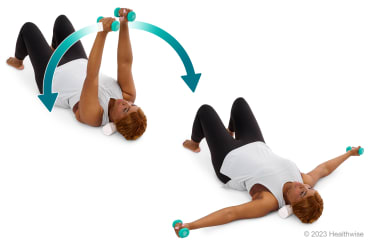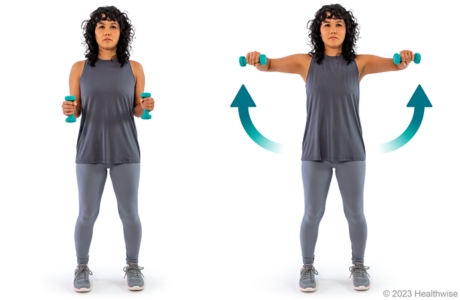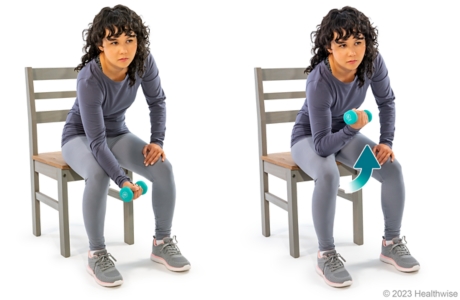Introduction
Here are some examples of exercises for resistance training. Start each exercise slowly. Ease off the exercise if you start to have pain.
Your doctor or physical therapist will tell you when you can start these exercises and which ones will work best for you.
How to do the exercises
Chest fly (lying down)

slide 1 of 3
slide 1 of 3, Chest fly (lying down),
- Lie on a bench or exercise ball, and hold light weights straight up over your chest. You can also use soup cans or filled water bottles for weights. Do not lock your elbows. You can keep them slightly bent if that is more comfortable.
- Slowly lower your arms, keeping them extended, until the weights are level with your chest or slightly lower.
- Slowly raise your arms until you are in the starting position.
- Repeat 8 to 12 times.
Arm raise to the side (elbows bent)

slide 2 of 3
slide 2 of 3, Arm raise to the side (elbows bent),
- Stand with your feet shoulder-width apart and your knees slightly bent. Or sit up straight in a chair.
- Hold a 1- to 2-pound weight in each hand. The weight may be a dumbbell, a can of food, or a filled water bottle.
- Bend your elbows 90 degrees while keeping them at your sides. With your palms facing in, hold the weights straight in front of you.
- Slowly lift the weights and your elbows out to the sides to shoulder level, keeping your elbows bent. Keep your shoulders down and relaxed as you lift. If you find that you are shrugging your shoulders up toward your ears, your weights may be too heavy. Try using lighter weights (or even no weights).
- Slowly lower the weights and your elbows until your elbows are back at your sides.
- Repeat 8 to 12 times.
Biceps curl

slide 3 of 3
slide 3 of 3, Biceps curl,
- Sit leaning forward with your legs slightly spread apart and your left hand on your left thigh.
- Hold a 1- to 2-pound weight in your right hand. The weight may be a dumbbell, a can of food, or a filled water bottle.
- Place your right elbow on your right thigh, keeping your elbow slightly bent.
- Slowly lift (curl) the weight up and toward your chest.
- Slowly return it to the starting point.
- Repeat 8 to 12 times.
- Repeat these steps with your other arm.
Current as of: June 5, 2023
Author: Healthwise Staff
Clinical Review Board
All Healthwise education is reviewed by a team that includes physicians, nurses, advanced practitioners, registered dieticians, and other healthcare professionals.

